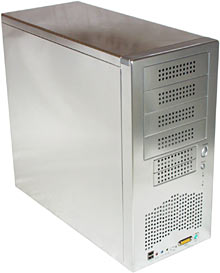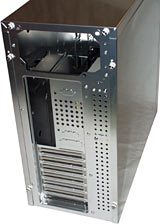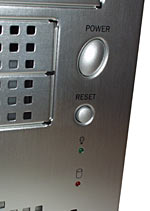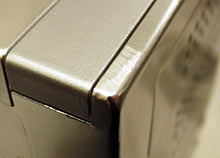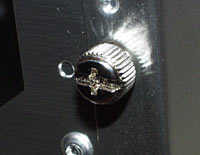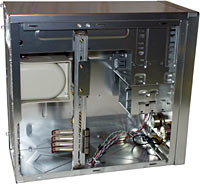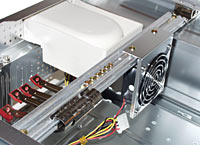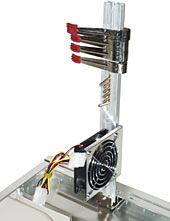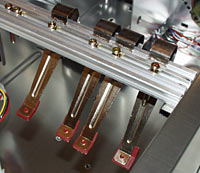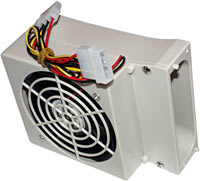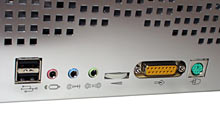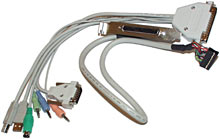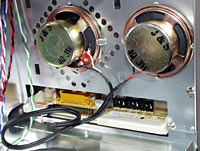
Skyhawk Eagle AL-ATX4378+C-SL computer case
Review date: 2 April 2001.Last modified 03-Dec-2011.
It's aluminium. It's shiny. It's light, it's expensive, it doesn't come with a power supply, and it's not made by Lian Li.
Here in Australia, at least, there's something of a craze for snazzy-looking aluminium computer cases. The most popular of them is Lian Li's PC-60, which I review here.
The Lian Li cases are far more expensive than ordinary steel PC enclosures - especially when you remember that most cases come with a Power Supply Unit (PSU), and the Lian Lis don't. But they're easy to work on, have more room inside than you'd think, have a lot of ventilation, and look great. So they're a popular item.
Skyhawk's longwindedly named Eagle AL-ATX4378+C-SL case is aimed at the same market as the PC-60, and it's got a couple of features the Lian Li can't match. In some other departments, it loses. And some of its features are just weird.
On with the show.
Look and feel
At a glance, the Eagle looks better than the Lian Li PC-60, at least if you dig shiny things. Like the PC-60, the Eagle it has a brushed aluminium finish, but the finish is more brightly polished - it's actually somewhat reflective, not the usual matte look.
The finish is protected with a clear gloss coat that ought to reduce the susceptibility of shiny aluminium to unsightly scratches and dings.
Pick the Eagle up, and you'll find that it weighs not a lot. All aluminium cases are very light compared with similarly sized steel ones; the empty Eagle is, perhaps, a bit lighter than an empty PC-60. Small differences like this all become pretty much irrelevant once you build a computer into the case. Yes, aluminium cases will give you a lighter PC, but the difference isn't night and day.
The Eagle's front panel buttons are silver plastic that matches the panel; the LEDs are small and unobtrusive; the ventilated pop-out drive bay covers are snazzy looking.
Under those nice looking bay covers, though, the Eagle has industry standard stamped metal wiggle-them-out-with-a-screwdriver bay opening covers, though. No Lian Li case makes you wrestle with those things.
While we're talking cosmetics, the front panel corners seem to have been kissed with an angle grinder to get them to line up properly with the top panel. It's not a very noticeable flaw, and nothing actually buzzes or rattles, but this is just one symptom of overall fit and finish isn't quite up to Lian Li standards.
By ordinary cheapo case standards, the Eagle is very well put together. But the thing costs a lot more than an ordinary cheapo case. It costs exactly the same as a PC-60, in fact - $AU396 delivered, here in Australia. There's a version of the Skyhawk without the front connector panel (of which more in a moment) that's only $AU313.50, delivered, but that's not a huge difference.
Almost all of the Eagle's case fasteners are thumbscrews, as with the Lian Li cases. These ones have combination heads to suit pretty much any kind of driver, and they make it easy to work on the computer without tools.
Inside
The Eagle has thinner side panels than the Lian Li models, whose panels already feel a bit flimsy. Which is fine - the side panels aren't structural, and as long as they don't rattle, it doesn't matter if you can use them as a wobble-board when you take them off.
Remove a side panel and you see... well, you see all sorts of peculiar things. Let's deal with the practicalities first.
The PC-60 offers four 5.25 inch bays, all of which have a front panel cutout (they're "external" bays), plus no fewer than six 3.5 inch bays - three external, three internal.
The Skyhawk's top and middle drive bay cages are laid out almost the same as the PC-60's, but it lacks the Lian Li case's bottom drive bay. So it only offers four external 5.25 bays, two external 3.5, and one internal 3.5. And none of those bays have cooling fans pointed at them by default. A big selling point for the Lian Li cases are their standard twin front fans, which blow over the bottom three 3.5 inch bays.
You do get two fans in the Eagle, though.
One of them's hanging from this brace that connects the top of the case to the bottom.
Undo one screw at the bottom of the brace and you can fold it up, which you'll have to if you want to install a motherboard. The brace-mounted fan blows from front to back, by default; if you for some reason wanted it to work the other way, it'd be easy to unscrew it and turn it around.
The other thingies sticking out from the brace are card holders. They're spring-steel arms with a moulded plastic fitting at the end to engage the top of an expansion card, pushing it firmly down into its slot.
You lock the card holders in place by tightening one of the provided screws down onto a groove in the middle of the holder. It's a slightly gimcrack but effective enough system; the hold-down screws are held to the brace by a sliding captive nut arrangement that feels dodgy while you're moving them, but works fine when they're tightened.
There are only four card-holders, but there are six screws. Two of the screws are extra long, so you can use them to push the holders low enough to clamp low-profile cards, as well as normal-sized ones.
Frankly, I think any event dramatic enough to make a card-clamp like this necessary would break your computer in some other way. You see these sorts of arrangements commonly enough in industrial-strength server cases that are built to survive abuse, but the Eagle case isn't that solid. Neither's a PC-60, mind you.
Card clamps are essential for very heavy cards, like the old "hard cards" that combined a hard drive controller and a drive on the one board, back in the days when people were still buying computers that didn't have a hard drive controller as standard equipment. Aligned any way but vertically, a hard card will overstress its slot without some extra support. Most computers that used such cards just had a slotted plastic thing for the other end of the cards to sit in, but there were various other retainer designs.
For ordinary expansion cards, though, these clamps are overkill. I can't help but think that the whole hinged arm arrangement is really just there to make the case less likely to fold up like a poorly designed bridge if someone's foolish enough to sit on it. A PC-60 makes a pretty good Butt to Ground Adapter (note - I have not engaged the services of any very large people to test the case's limits), but I'm not so sure about the Eagle.
To save you paging up, here's that picture of the folded-down arm again. Note the beige thing in the background. That's the second extra fan.
It's another standard 80mm unit, but it's installed in this housing to make it behave as a blower, sucking air from the rear of the case and blowing it down onto the CPU area. The two extra fans thus both blow air at the CPU, which may or may not be exactly what you want, depending on the kind of CPU cooler you're using and which way it wants to shift the air.
The fan in the blower housing can also be reversed, as the housing's just held together with four screws. But either way, it doesn't move nearly as much air as the fan on the brace-arm. The housing is not a masterpiece of duct design. I dare say it does no harm, but it's another thing you'll have to remove and replace when you install a motherboard in the Eagle.
All of the medium-to-large Lian Li cases have a rear exhaust fan or two as standard. The PC-60 has one; the PC-70 (which I review here) has two. They don't have any ducting; they just facilitate the straight-through airflow path that starts with the two front intake fans. Fans inside the case, like the one dangling in the middle of the Eagle, are of questionable value unless they're attached directly to some particular heat sink - or to a duct that leads straight to it. A well ventilated case should have enough airflow that interior fans contribute nothing much to general cooling.
The Eagle case also loses to various Lian Lis, including the small-form-factor PC-31 I review here, because it doesn't have a slide-out motherboard tray. This means it's really no easier to set up or work on than any ordinary midi-tower, even if you ignore the weird brace-arm. A motherboard tray is a handy and unusual feature of the Lian Lis - you don't normally get a tray on smaller cases, even though they're more likely to have a lot of cables in a small area than a full tower case, and thus actually need a tray more.
All Lian Li cases are pretty good at keeping sharp metal edges away from the questing fingers of the computer assembler. There are a few nasty bits around the PSU mount, but it's not very treacherous. They're certainly not in the same league as the cheap stamped metal cases that lop off small parts of IT professionals every day.
The Eagle is...
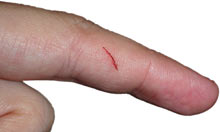
...almost as good as a Lian Li. Its sheet metal parts have rolled edges in most places, but it's not hard to find a place where one didn't.
Well, I didn't find it hard, anyway.
What's the Eagle got that the PC-60 can't match, then?
Two things.
Port panel
Lian Li are doing front-ported cases now - their "+USBS" variants on the PC-6x series all have four USB ports at the bottom of the front panel. The Eagle, though, gives you almost the full suite of standard back-of-box connectors relocated to the front.
Two USB ports, microphone in, line in, speaker out (with a volume control!), and a PS/2 connector that you can use for mouse or keyboard.
How's that all work, I hear you ask?
Well, more elegantly than you might think.
Like all port-relocator gizmoes for standard PCs, the Eagle front ports hook up to the standard ports via a plain cable connection. Many such things just have a selection of cables that loop through a hole in the back of the box straight to the front panel, but the Eagle's a bit more elegant. It has a two-part cable, with a chunky 37 pin D connector in the middle.
The D connection's mounted on a standard rear-slot metal tab, so you screw it in place wherever's convenient, thread a cable through the inside of the computer and plug it into the connector on the back of the front panel. Then you plug the second half of the relocator cable into the back panel socket, and connect it to all of the rear panel motherboard sockets you want to relocate.
The connector's a bit of a monster, but at least there are no weird cable grommets on your back panel, or wires getting worn away by stamped metal edges.
Gettin' weirder
Here's the back of the front panel connector circuit board, with the pin block for the foreward end of the internal port replicator cable.
And, above it, you'll see the stereo speakers.
If you're now making "huh?" noises, I assure you that I did, too. But there the danged things are. Held on the front panel with the usual three-clips-and-a-nub-of-metal, which makes it easy enough to remove them if you want to install a fan there instead.
The speakers connect to the end of the block of pins that the interior half of the port replicator cable plugs into, and they play whatever comes in from the "speaker out" connection. The front panel volume control works with them, and if you plug something into the front panel sound output connection (which, thanks to the volume control, is fine for line out or headphones), the internal speakers are muted.
The speakers aren't very loud, because they're small and magnetically shielded and unamplified. And they're only separated by about three inches, so there's no stereo effect to speak of. And you get them instead of a normal case speaker, which connects to the speaker pins on your motherboard and gives you your startup and DOS-mode beeps.
You could plug one or both of these speakers into normal motherboard speaker output, no problem, if you had the right kind of adapter cable - or just hacked the right plug onto the end of the speaker wires. But no adapter cable is included.
There is a motherboard connector adapter included, but it's for the power LED connector. It lets you convert the wide-spaced connector that the cable from the front panel LED uses into the narrow-spaced version that some motherboards want. That doesn't help you with the speakers, though.
So I do not see the sexiness of the built in speakers, for most users. They might be handy for standalone server purposes, or something, but they're quiet and sound lousy. The Lian Li strategy of putting two fans and three more drive bays in that part of the case seems rather more sensible to me.
Overall
For the money, I'd much rather have a PC-60 than this odd Eagle thing.
OK, the Skyhawk case has a pretty and quite durable finish, handy front ports, and extra CPU fans.
But the central brace is more awkward than useful, there are speakers where there should be fans, there aren't enough drive bays for a really stacked computer, the Eagle's not as nicely made as the Lian Li, and it doesn't even have the decency to be cheaper.
If you want a lightweight aluminium case with card restraints, for some reason, then here one is. And the front ports may utterly turn your crank; I can take them or leave them, personally. Perhaps the thing will be cheaper in different markets, too; if it cost half as much as a PC-60 it'd be a good buy.
For the same money as a PC-60, though, this is a not very desirable oddity. If one or another of the Eagle's extras doesn't capture your imagination, you needn't bother with it.
